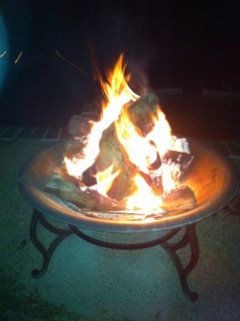Last night before bed, I wrapped myself up in a coat, grabbed my Meerschaum churchwarden, a tin of tobacco, and proceeded out into the frigid night air. Overhead, the sky was crystal clear and the night enjoyed a welcomed calm wind. The Geminids meteor shower was about to start and I wanted to get a preview of the show. Often, when one grabs a pipe, contemplation sets in and like my pipe smoke, my thoughts and gaze drift skyward.
To me, the constellations are like old friends. They faithfully appear at their appointed time every year and are yet another reminder of the changing seasons. We humans are creatures of habit and most find comfort in some sort of routine. The seasons set a grand framework that we have long set our lives around. As I stare into the firmament, I visit my friends.
With its ruby eye, Taurus eyes Orion down while Orion stands his ground and prepares for yet another charge from the celestial beast. The Twins look on indifferently as they have seen this scene before countless times. Both of Orion’s hunting dogs stand faithfully by his side in anticipation for the coming blow.
My earliest memories are of the sky and the first constellation I learned was Orion. His belt stood out to me as they are almost in a perfect line and separation, a wonderful chance alignment that we get to enjoy here on Earth. Our ancestors noticed it too. In the Book of Job, it is mentioned “Can you loosen Orion’s Belt?” (38:31) Those three stars are like a beacon that beckons us heavenward.
The region occupied by Orion consists of a huge star making complex that is in large part obscured by interstellar dust. The Great Orion Nebula stands out as a blister and provides a glimpse into this vast star forming region. When one peers deeper into the nebula, baby stars can be seen burning hotly, as new stars often do, taking their first steps into the void. They burn away the local remnants of the gas and dust cloud that formed them and as a result, the surrounding gas will glow. Sometime in the far future, these stars will drift away from their birthplace and form new constellations for some future generation to gaze upon. In fact, most of the stars of the Big Dipper were born in the area of Orion as well as most of the stars in Orion itself.
Standing out among its younger siblings is mighty Betelgeuse, huge and smoldering red like the flame in my pipe. It is showing its age. It has become moody as it changes in brightness to let everyone know that it is reaching the end of its life. Someday, in the not too distant future, it will flame out in a spectacular fashion and be one of the brightest objects in our night sky. It will cast shadows during the night and be seen in the daytime. Thankfully, we are far enough away to witness the event in safety.
I look down to into my pipe bowl and notice that its flame has gone out. I have finished my bowl and it is time to turn in. I enjoyed my time with my friends and look forward to seeing them again on these rare, cloudless winter nights in Ohio. Before I leave, I look up one last time and witness the fiery death of a piece of comet dust: a meteor blazes a trail across the sky.
Good night friends.
To me, the constellations are like old friends. They faithfully appear at their appointed time every year and are yet another reminder of the changing seasons. We humans are creatures of habit and most find comfort in some sort of routine. The seasons set a grand framework that we have long set our lives around. As I stare into the firmament, I visit my friends.
With its ruby eye, Taurus eyes Orion down while Orion stands his ground and prepares for yet another charge from the celestial beast. The Twins look on indifferently as they have seen this scene before countless times. Both of Orion’s hunting dogs stand faithfully by his side in anticipation for the coming blow.
My earliest memories are of the sky and the first constellation I learned was Orion. His belt stood out to me as they are almost in a perfect line and separation, a wonderful chance alignment that we get to enjoy here on Earth. Our ancestors noticed it too. In the Book of Job, it is mentioned “Can you loosen Orion’s Belt?” (38:31) Those three stars are like a beacon that beckons us heavenward.
The region occupied by Orion consists of a huge star making complex that is in large part obscured by interstellar dust. The Great Orion Nebula stands out as a blister and provides a glimpse into this vast star forming region. When one peers deeper into the nebula, baby stars can be seen burning hotly, as new stars often do, taking their first steps into the void. They burn away the local remnants of the gas and dust cloud that formed them and as a result, the surrounding gas will glow. Sometime in the far future, these stars will drift away from their birthplace and form new constellations for some future generation to gaze upon. In fact, most of the stars of the Big Dipper were born in the area of Orion as well as most of the stars in Orion itself.
Standing out among its younger siblings is mighty Betelgeuse, huge and smoldering red like the flame in my pipe. It is showing its age. It has become moody as it changes in brightness to let everyone know that it is reaching the end of its life. Someday, in the not too distant future, it will flame out in a spectacular fashion and be one of the brightest objects in our night sky. It will cast shadows during the night and be seen in the daytime. Thankfully, we are far enough away to witness the event in safety.
I look down to into my pipe bowl and notice that its flame has gone out. I have finished my bowl and it is time to turn in. I enjoyed my time with my friends and look forward to seeing them again on these rare, cloudless winter nights in Ohio. Before I leave, I look up one last time and witness the fiery death of a piece of comet dust: a meteor blazes a trail across the sky.
Good night friends.







 :
:

